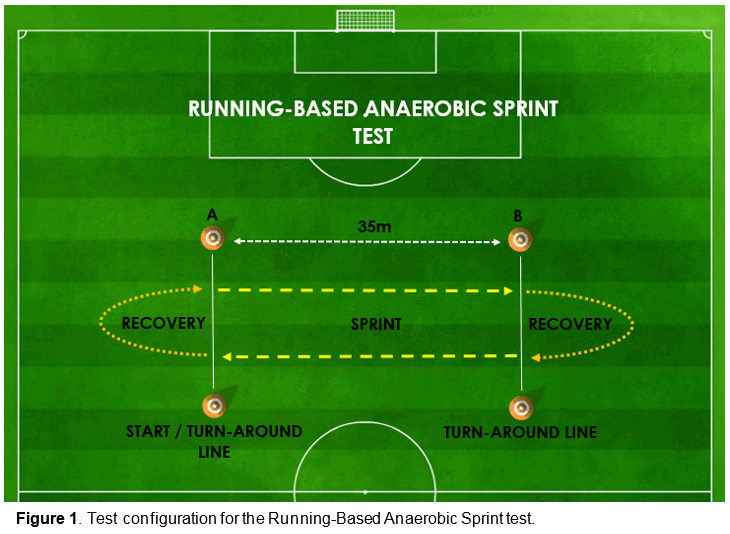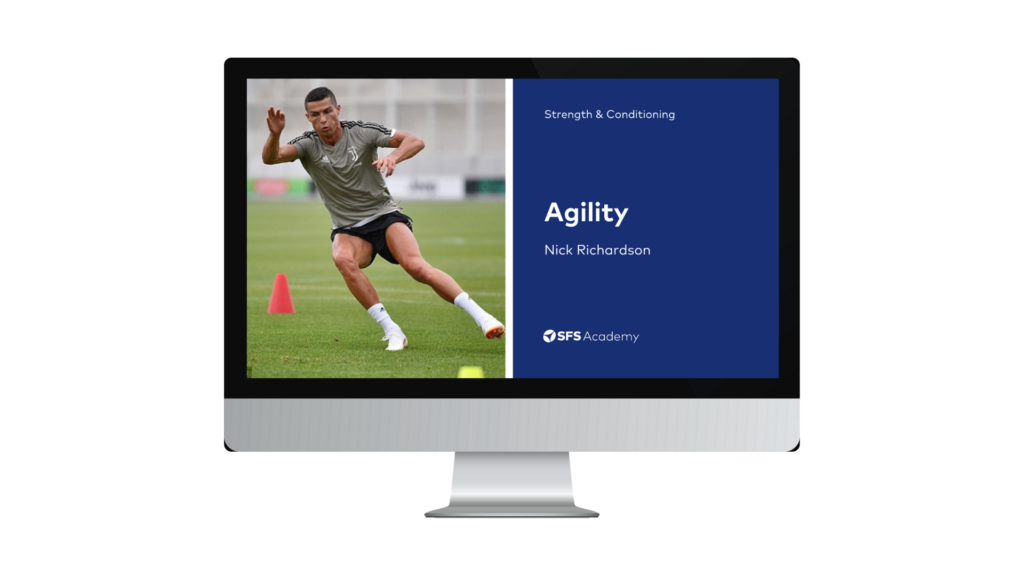Contents of Article
- Summary
- What is the Running-Based Anaerobic Sprint Test (RAST)?
- Who should use the Running-Based Anaerobic Sprint Test?
- How do you conduct the Running-Based Anaerobic Sprint Test?
- How do you score the Running-Based Anaerobic Sprint Test?
- How do you calculate your Running-Based Anaerobic Sprint Test score?
- Considerations for using the Running-Based Anaerobic Sprint Test
- Is the Running-Based Anaerobic Sprint Test valid and reliable?
- References
- About the Author
Summary
Developed in the late 1990s, the Running-Based Anaerobic Sprint Test was designed to measure anaerobic power and capacity. It is a simple test, requiring little equipment and boasts significant test validity and reliability. Many useful variables can be extracted simply from this test, and thus it is often a favourable choice for strength and conditioning coaches and sports scientists.

What is the Running-Based Anaerobic Sprint Test (RAST)?
Developed in the UK in 1997 by Draper and Whyte (1) at the University of Wolverhampton, the Running-Based Anaerobic Sprint Test (RAST) is a testing protocol designed to measure anaerobic power and capacity (2). The test involves six sprints over a 35-metre distance, with a 10-second recovery between each sprint. Due to its accuracy as a test and its simplicity, the RAST is commonly used by exercise professionals to monitor performance.
Who should use the Running-Based Anaerobic Sprint Test?
The RAST is capable of identifying two primary measures via a running-based protocol: 1) anaerobic capacity, and 2) anaerobic power. As these values are vital factors in sports that demand repeated short-duration maximal efforts, this particular test may be a suitable assessment tool for athletes who compete in running-based sports and are exposed to similar workloads – such as football (soccer), basketball, and handball (2).
How do you conduct the Running-Based Anaerobic Sprint Test?
It is important to understand that whenever fitness testing is performed, it must be done so in a consistent environment (e.g. facility) so that it is protected from varying weather types, and with a dependable surface that is not affected by wet or slippery conditions. If the environment is not consistent, the reliability of repeated tests at later dates can be substantially hindered and result in worthless data.
Equipment requirements
Before the start of the test, it is important to ensure you have the following items:
- Reliable and consistent testing facility of at least 50m in length (e.g. indoor hall or artificial sports field).
- Test administrators (minimum of two). One administrator times the duration of each sprint, whilst the other times the 10-second recovery periods.
- Weighing scales
- Timing gates (preferred, but not essential)
- Measuring tape (≥35m)
- Stopwatch
- Marker cones
- Performance recording sheet
Test configuration
Figure 1 displays the test configuration for the RAST – this setup must be adhered to if accurate and reliable data is desired.

Testing procedure
- Calculate body mass (kg)
- Participant must be weighed in lightweight clothing with shoes and accessories removed.
- Warm-up
- Participants should thoroughly warm up prior to the commencement of the test. Warm-ups should correspond to the biomechanical and physiological nature of the test. In addition, sufficient recovery (e.g. 3-5 minutes) should be administered following the warm-up and prior to the commencement of the test.
- Starting the test
- The participant should ready themselves in a ‘standing start position’ at one end of the 35m sprint track (i.e. cone A – Figure 1).
- The second test administrator should count down the start of the test (“3 – 2 – 1 – GO!”)
- On the “GO” signal, both test administrators press the start button on the stopwatch and the participant must sprint at maximal effort to the end of the 35m track (i.e. cone B).
- As soon as the participant crosses the 35m line, the second test administrator (standing on the end line) must shout “CLEAR”, at which point they stop the clock and record the sprint duration. The first test administrator begins the countdown of the 10-second recovery.
- During the recovery period, the participant should get ready to perform another 35m sprint back to where they started.
- The test administrators should be recording the duration of all six sprints individually to the nearest hundredth of a second and officiating the 10-second recovery.
- Repeat this procedure for a total of six sprints (five 10-second recovery periods).
- After the test
- Once the test is over, some subjects may react to the previous exertion. To reduce any problems, the subjects should rest, either sitting or standing, for at least 2-3 minutes. If the subject feels ill or goes quiet or pale, they should lie down with their feet resting on a chair. Note: never leave the participant alone after the test.
How do you score the Running-Based Anaerobic Sprint Test?
If timing gates are not available, then test administrators should have recorded the duration of each sprint to the nearest hundredth of a second. These sprint times, along with body mass, are then used to calculate anaerobic capacity and power outputs.
How do you calculate your Running-Based Anaerobic Sprint Test score?
The results of the test can be calculated using the formulas:
Key Values – Power (Watts); Body mass (kilograms); Distance (metres); Time (seconds); Velocity (seconds); Acceleration (seconds); Force (Newtons).
How to: Calculate Peak Power Output (PPO)
- PPO = Body mass * Distance ² ÷ Time ³
From the six sprint times and PPOs, you can then calculate the following:
- Maximum power output (i.e. the highest value)
- Minimum power output (i.e. the lowest value)
- Average power output (i.e. the sum of all six values ÷ 6)
How to: Calculate Fatigue Index (FI)
This value represents the rate at which the power (W) declines in the participant’s performance. The lower the value the better the participant’s ability to maintain performance, and vice versa. Participants with high FI values may need to improve their anaerobic capacity and resistance to fatigue.
- FI = (Maximum power – Minimum power) ÷ Total time for the 6 sprints
How to: Calculate Relative Peak Power Output (RPP)
This unit of measurement allows for a somewhat fair comparison between participants of various weights and sizes.
- RPP = peak power ÷ body weight
How to: Calculate Anaerobic Capacity (AC)
Anaerobic capacity is the total work completed during the test duration.
- AC = Sum of all six sprint PPOs
Considerations for using the Running-Based Anaerobic Sprint Test
When conducting the test, there are several factors that need to be taken into consideration before you begin – some being:
- Accuracy of stopwatch – If timing gates are not available, then it is imperative test administrators understand the inconsistencies of using a stopwatch for their results. As a result, administrators must pay great attention and attempt to communicate clearly in order to maximise the accuracy of the results.
- Circadian variations – circadian rhythms can significantly alter power outputs during such anaerobic performance tests (3). Current knowledge suggests early morning anaerobic tests will elicit significantly lower peak power values than late afternoon or evening tests.
- Surface and conditions – Before conducting the test, ensure the surface is non-slip and consistent (e.g. not affected by weather). Secondly, ensure the environment/facility is also consistent and not affected by weather conditions.
- Individual effort – Sub-maximal efforts can result in inaccurate and meaningless scores.
Is the Running-Based Anaerobic Sprint Test valid and reliable?
Previous research has demonstrated the RAST can be used as a valid and reliable measure of peak power, mean power, and fatigue index (2). Furthermore, a recent study has also demonstrated that the paediatric RAST (modified RAST) is also a valid and reliable measure in healthy young children (4).
- Draper, N. and Whyte, G. (1997) Here’s a new running based test of anaerobic performance for which you need only a stopwatch and a calculator. Peak Performance, 96, p. 3-5. [Link]
- Zagatto, A.M., Beck, W.R., & Gobatto, C.A. (2009). Validity of the running anaerobic sprint test for assessing anaerobic power and predicting short-distance performances. J Strength Cond Res.23(6):1820-1827. [PubMed]
- Teo, W., Newton, M.J., & McGuigan, M.R. (2011). Circadian rhythms in exercise performance: Implications for hormonal and muscular adaptation. Journal of Sports Science and Medicine, 10, pp.600-606. [PubMed]
- Bongers, B.C., Werkman, M.S., Blokland, D., Eijsermans, M.J.C., van der Torre, P., Bartels, B., Verschuren, O., & Takken, T. (2015). Validity of the Pediatric Running-Based Anaerobic Sprint Test to Determine Anaerobic Performance in Healthy Children. Pediatric Exercise Science, 27, 268-276. [PubMed]




